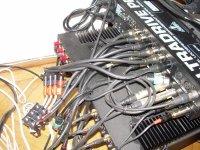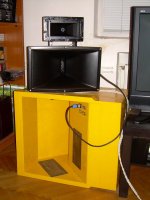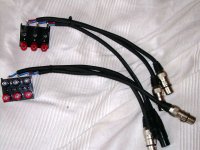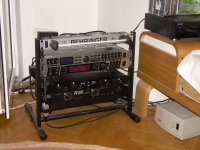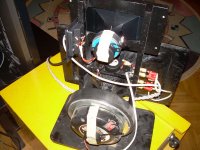I found it (took me all that time...)
http://www.diyaudio.com/forums/showthread.php?p=726684#post726684
210dB/oct initial slope!
I cannot find the post with the exact ratio of each filter and eq though.
I keep searching!
http://www.diyaudio.com/forums/showthread.php?p=726684#post726684
210dB/oct initial slope!
I cannot find the post with the exact ratio of each filter and eq though.
I keep searching!
Last edited:
I want to use it for a 10khz crossover to a UHF ring radiator.
At these frequency you always have comb filtering, and trying to time aligne is pointless, because the wave lengths are so small.
according to Greg Timbers, about the design of the JBL S98000 :
so the steeper the slope, the smaller the comb filtering.
I contacted member sfogg to know the precise filter/eq ajustements he used.
At these frequency you always have comb filtering, and trying to time aligne is pointless, because the wave lengths are so small.
according to Greg Timbers, about the design of the JBL S98000 :
The comb filter effect is normal and cannot be eliminated, even with the use of electronic delay. The wavelength at 10k is an inch or less and even if the 045be were delayed to the z plane of the 435Be, even the slightest movement up, down, left or right of the measurement position would change the relative path length between the 435Be and 045Be to where the interference pattern would return.
so the steeper the slope, the smaller the comb filtering.
I contacted member sfogg to know the precise filter/eq ajustements he used.
Last edited:
does measuring confirm that the extra steepness is achievable in practice?Andrew, The trick can be used with either unit. The "trick" is to hug a PEQ or notch filter right next to the crossover filter. The extreme steepness is only within the first octave or so.
I would not be surprised to find that the specification does not confirm you can achieve what the "trick" looks like it might do.
measurements of the outputs of the DCX can be found in the link I posted above
An externally hosted image should be here but it was not working when we last tested it.
that frequency response plot shows the extra steepness is available only within the first one sixth of an octave (~100Hz for a 600Hz roll off).The extreme steepness is only within the first octave or so.
But, it's nice to know that the DCX does not have an inherent 48dB/octave steepness limit and that cascading filters can indeed allow each to perform as expected.
Some results from using 100V trafos with DCX and my horns
As I've promised I show you some results using 100V trafos with my horns (105-110dB@1W/1m) and DCX2494/DEQ2496. From the possible scenarios I tested two:
1. DCX outputs --> poweramps -->trafos --> horns
2. DCX outputs --> trafos --> horns
My system used to be something like this: DCX outputs --> -20/30dB attenuators --> poweramps (-20dB) --> horns and I had trouble with brum and limited volume control to accomodate various digital source levels.
After setting 1. I can take out all resistive attenuators and need only -15dB of amplifier input attenuation to get needed acoustic level in my room. I haven't any kind of noise (brumm etc.) and can accomodate more easily digital source levels using only DEQ2496 digital volume. I am listening symphonic music and I was extremely satisfied with the results.
After that I want to try taking out poweramps and the situation were something similar but I've got some limitation on the treble channel at high volume because these have about -12dB less sensivity. So, I cannot listen to big symphonic works without clipping treble channel and have returned to situation 1.
Meantime I have studied the possibility to change the treble channel (ribbons on horns) and find that Eminence's APT150 is the perfect candidate with phenolic membrane, 90x40 coverage and 105dB. I made the change and now can use either 1 or 2 scenario but choose the more traditional 1 and seems I stay with it from now on.
As I've promised I show you some results using 100V trafos with my horns (105-110dB@1W/1m) and DCX2494/DEQ2496. From the possible scenarios I tested two:
1. DCX outputs --> poweramps -->trafos --> horns
2. DCX outputs --> trafos --> horns
My system used to be something like this: DCX outputs --> -20/30dB attenuators --> poweramps (-20dB) --> horns and I had trouble with brum and limited volume control to accomodate various digital source levels.
After setting 1. I can take out all resistive attenuators and need only -15dB of amplifier input attenuation to get needed acoustic level in my room. I haven't any kind of noise (brumm etc.) and can accomodate more easily digital source levels using only DEQ2496 digital volume. I am listening symphonic music and I was extremely satisfied with the results.
After that I want to try taking out poweramps and the situation were something similar but I've got some limitation on the treble channel at high volume because these have about -12dB less sensivity. So, I cannot listen to big symphonic works without clipping treble channel and have returned to situation 1.
Meantime I have studied the possibility to change the treble channel (ribbons on horns) and find that Eminence's APT150 is the perfect candidate with phenolic membrane, 90x40 coverage and 105dB. I made the change and now can use either 1 or 2 scenario but choose the more traditional 1 and seems I stay with it from now on.
Attachments
Yes, these are 100V/2.5w/5W/4ohm transformers; so 22:1 (5W) or 32:1 (2.5W) ratio for tension and 500:1 (5W) or 1000:1 (2.5W) ratio for impedance. I'm using the most expensive ones, toroids, fully shielded, large bandwidth. For my system, DCX and DEQ and 100V trafos aleviate the need for any 6 or 8 channel volume control. For volume duties I'm using the +/-15dB digital volume of the DEQ2496 which stay near 0dB at the prefered listening level. Also, DCX outputs and poweramps are working now at some voltage excursion, more relaxed and out of crossover distorsion zone, not the case before.
Worth to mention that sub-bass channels (<80Hz) are taken from DEQ's analog outputs, follow the same digital volume control like main channels but are not using trafos, just a pair of resistive attenuators.
Worth to mention that sub-bass channels (<80Hz) are taken from DEQ's analog outputs, follow the same digital volume control like main channels but are not using trafos, just a pair of resistive attenuators.
Last edited:
Sorry to hijack this thread a little but it is so long it is difficult to find details when I search.
I have a couple of questions regarding potential upgrades that should be fairly fundamental from what I've seen in some of the posts but here we go:
In terms of the digital input, I'm not sure yet whether I'm going to go AES/EBU or S/PDIF but in either way, is it worthwhile swapping the stock digital TX for say the LL1572 or LL1574? These are £20 in the UK. Are they good value and a reasonable upgrade or would other txs be recommended? Ho difficult would it be to change (I guess this would be one of the easier mods on the main board).
I am initially progressing with the following passive output mod, http://http://www.dcx2496.fr/en/tweakanalog1.php but also trying to find a passive mod for the analogue inputs, or even a transformer scheme. Can anyone point me in the right direction but for the moment, I'd be looking to break into the input board to main biard ribbon rather than remove/replace smd components.
Sorry once again for such basic questions that I guess have been answered before somewhere.
I have a couple of questions regarding potential upgrades that should be fairly fundamental from what I've seen in some of the posts but here we go:
In terms of the digital input, I'm not sure yet whether I'm going to go AES/EBU or S/PDIF but in either way, is it worthwhile swapping the stock digital TX for say the LL1572 or LL1574? These are £20 in the UK. Are they good value and a reasonable upgrade or would other txs be recommended? Ho difficult would it be to change (I guess this would be one of the easier mods on the main board).
I am initially progressing with the following passive output mod, http://http://www.dcx2496.fr/en/tweakanalog1.php but also trying to find a passive mod for the analogue inputs, or even a transformer scheme. Can anyone point me in the right direction but for the moment, I'd be looking to break into the input board to main biard ribbon rather than remove/replace smd components.
Sorry once again for such basic questions that I guess have been answered before somewhere.
DCX 2496 output level not too high for some
It's a common theme here that the output of the DCX 2496 is too high for many amplifiers. However, I'm not exactly sure if that is true for my Krell FPB 300 using balanced XLR input.
The FPB 300 manual is no longer online, but the rating for the similar Krell 400CX shows "input sensitivity" of 2.71 V. That would be for the rated output of 400 Watts into 8 ohms. However, just like that amplifier, my FPB 300 can actually put out more than 500W into 8 ohms. So, roughly speaking, I'd probably want the driving device to be able to put out at least 4V to reach the amplifiers full capacity.
The DCX output is 22dBu, which is about 9.75V, or about just over twice the minimum required. You could say that's 6dB too much, or you could say that the driving device has "6dB headroom", which actually sounds about ideal.
Another factor is the question of whether the DCX is really at it's best putting out the full 9.75V output. Quite possibly the low end analog output circuitry, if not the midline AKG DAC, work best a few dB below their max output levels.
Now this year my 10 year old Krell did develop a problem in one channel. The factory did a repair/refurb replacing about 100 capacitors and two chips in the automatic bias circuit. I asked specifically if the amplifier could have been damaged by excessive voltage input, and the service manager said no, it was just a matter of age. I'm posting this query because I want some other opinion.
I note that the output of a high end preamplifier, the Levinson ML 38 and it's successors, actually put out even more voltage than the DCX, at least they are specified to put out 16 volts RMS maximum.
Now still I'm a bit concerned about how these balanced voltages are measured. Is there an ambiguity here, such as measuring both signals to ground vs. both signals to each other?
It's a common theme here that the output of the DCX 2496 is too high for many amplifiers. However, I'm not exactly sure if that is true for my Krell FPB 300 using balanced XLR input.
The FPB 300 manual is no longer online, but the rating for the similar Krell 400CX shows "input sensitivity" of 2.71 V. That would be for the rated output of 400 Watts into 8 ohms. However, just like that amplifier, my FPB 300 can actually put out more than 500W into 8 ohms. So, roughly speaking, I'd probably want the driving device to be able to put out at least 4V to reach the amplifiers full capacity.
The DCX output is 22dBu, which is about 9.75V, or about just over twice the minimum required. You could say that's 6dB too much, or you could say that the driving device has "6dB headroom", which actually sounds about ideal.
Another factor is the question of whether the DCX is really at it's best putting out the full 9.75V output. Quite possibly the low end analog output circuitry, if not the midline AKG DAC, work best a few dB below their max output levels.
Now this year my 10 year old Krell did develop a problem in one channel. The factory did a repair/refurb replacing about 100 capacitors and two chips in the automatic bias circuit. I asked specifically if the amplifier could have been damaged by excessive voltage input, and the service manager said no, it was just a matter of age. I'm posting this query because I want some other opinion.
I note that the output of a high end preamplifier, the Levinson ML 38 and it's successors, actually put out even more voltage than the DCX, at least they are specified to put out 16 volts RMS maximum.
Now still I'm a bit concerned about how these balanced voltages are measured. Is there an ambiguity here, such as measuring both signals to ground vs. both signals to each other?
Trnsformer out balun
Hey, just thought I'd mention a quick trick I came across the other. Using transformers for the balanced to unbalanced conversion.
Yeah, I know - nothing new. You've been doing it for 100 years. Me too. But I normally pick up right at the DAC chip and go from there. Bypass the op amps. Works great. But here I'm talking about something a little different.
What I did was use the stock DCX XLR output, but ran it into some Jensen transformers to go to unbalanced. This replaced the resistor based cables I had used for years. And I was amazed at the difference! Soooo much better than any other bal/un I had used before.
My standard before was to use pin 2 as hot, pin 1 as ground and jump pin 3 to ground via 20K. I always thought this better than just shorting pin 3 to ground. But using the transformers sounds so much better. Not as good as completely bypassing the whole opamp section, for sure, but darn good.
If you have a set of transfos handy to try, please do so. I'd like to know what you think.
Hey, just thought I'd mention a quick trick I came across the other. Using transformers for the balanced to unbalanced conversion.
Yeah, I know - nothing new. You've been doing it for 100 years. Me too. But I normally pick up right at the DAC chip and go from there. Bypass the op amps. Works great. But here I'm talking about something a little different.
What I did was use the stock DCX XLR output, but ran it into some Jensen transformers to go to unbalanced. This replaced the resistor based cables I had used for years. And I was amazed at the difference! Soooo much better than any other bal/un I had used before.
My standard before was to use pin 2 as hot, pin 1 as ground and jump pin 3 to ground via 20K. I always thought this better than just shorting pin 3 to ground. But using the transformers sounds so much better. Not as good as completely bypassing the whole opamp section, for sure, but darn good.
If you have a set of transfos handy to try, please do so. I'd like to know what you think.
Not as good as completely bypassing the whole opamp section, for sure, but darn good.
If you have a set of transfos handy to try, please do so. I'd like to know what you think.
Yes if you have the trafos but otherwise just waiste of money i think.
I did sendlers passive mod and it sounds so much better than any op amp
or trafo.And cheaper.
Balanced outputs are measured differential (+against-). There is no way you destroyed your amplifier with excessive signal unless you were driving it well into clipping.
Yes, but what if the clipping isn't a steady thing, just a huge transient way above the clipping level?
Just changing EQ settings often seems to generate transients with DCX. But, I do find it hard to believe that DCX could generate a transient bad enough to destroy my power amp.
But it could generate a transient large enough to kick my Krell into its top bias plateau. That should be OK, it was designed to handle that. But if it was just about to break anyway, from heat and age, that could push it over the edge.
So the conclusion seems to be that it needed fixing anyway.
If safety were my top priority, I would use an XLR attenuator. But any attenuator is going to add noise and reduce bandwidth, the very opposite of what I want to do. Transformer could improve noise, but also reduce bandwidth and add some distortion. I'm sticking with direct connection to stock DCX now.
But what kind of output level could I get straight from the AKM DAC? Can I get that in full balanced mode, or is it single ended?
I did sendlers passive mod and it sounds so much better than any op ampor trafo.
Cheaper, for sure. But to my ears not as good. I much prefer the sound of transformer coupling to cap coupling. And prefer the sound of either to most opamps. A matter of taste I suppose.
Good transformers add so little distortion that it isn't really a worry. And what they do add seems benign to the my ear. But again, to each his own!
- Home
- Source & Line
- Digital Line Level
- Behringer DCX2496 digital X-over
